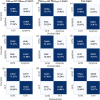Machine learning classification of cellular states based on the impedance features derived from microfluidic single-cell impedance flow cytometry
- PMID: 38274201
- PMCID: PMC10807927
- DOI: 10.1063/5.0181287
Machine learning classification of cellular states based on the impedance features derived from microfluidic single-cell impedance flow cytometry
Abstract
Mitosis is a crucial biological process where a parental cell undergoes precisely controlled functional phases and divides into two daughter cells. Some drugs can inhibit cell mitosis, for instance, the anti-cancer drugs interacting with the tumor cell proliferation and leading to mitosis arrest at a specific phase or cell death eventually. Combining machine learning with microfluidic impedance flow cytometry (IFC) offers a concise way for label-free and high-throughput classification of drug-treated cells at single-cell level. IFC-based single-cell analysis generates a large amount of data related to the cell electrophysiology parameters, and machine learning helps establish correlations between these data and specific cell states. This work demonstrates the application of machine learning for cell state classification, including the binary differentiations between the G1/S and apoptosis states and between the G2/M and apoptosis states, as well as the classification of three subpopulations comprising a subgroup insensitive to the drug beyond the two drug-induced states of G2/M arrest and apoptosis. The impedance amplitudes and phases used as input features for the model training were extracted from the IFC-measured datasets for the drug-treated tumor cells. The deep neural network (DNN) model was exploited here with the structure (e.g., hidden layer number and neuron number in each layer) optimized for each given cell type and drug. For the H1650 cells, we obtained an accuracy of 78.51% for classification between the G1/S and apoptosis states and 82.55% for the G2/M and apoptosis states. For HeLa cells, we achieved a high accuracy of 96.94% for classification between the G2/M and apoptosis states, both of which were induced by taxol treatment. Even higher accuracy approaching 100% was achieved for the vinblastine-treated HeLa cells for the differentiation between the viable and non-viable states, and between the G2/M and apoptosis states. We also demonstrate the capability of the DNN model for high-accuracy classification of the three subpopulations in a complete cell sample treated by taxol or vinblastine.
© 2024 Author(s).
Conflict of interest statement
The authors have no conflicts to disclose.
Figures







References
LinkOut - more resources
Full Text Sources
